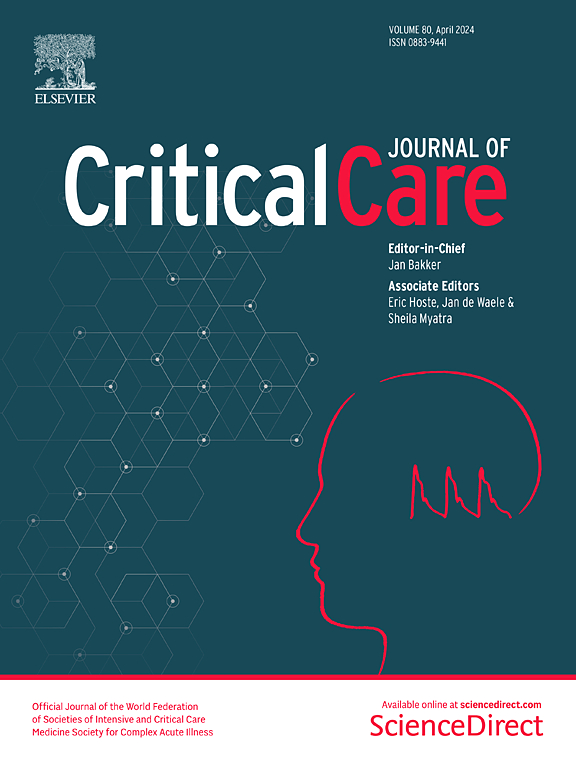Septic shock in the immunocompromised cancer patient: a narrative review
IF 8.8
1区 医学
Q1 CRITICAL CARE MEDICINE
引用次数: 0
Abstract
Immunosuppressed patients, particularly those with cancer, represent a momentous and increasing portion of the population, especially as cancer incidence rises with population growth and aging. These patients are at a heightened risk of developing severe infections, including sepsis and septic shock, due to multiple immunologic defects such as neutropenia, lymphopenia, and T and B-cell impairment. The diverse and complex nature of these immunologic profiles, compounded by the concomitant use of immunosuppressive therapies (e.g., corticosteroids, cytotoxic drugs, and immunotherapy), superimposed by the breakage of natural protective barriers (e.g., mucosal damage, chronic indwelling catheters, and alterations of anatomical structures), increases the risk of various infections. These and other conditions that mimic sepsis pose substantial diagnostic and therapeutic challenges. Factors that elevate the risk of progression to septic shock in these patients include advanced age, pre-existing comorbidities, frailty, type of cancer, the severity of immunosuppression, hypoalbuminemia, hypophosphatemia, Gram-negative bacteremia, and type and timing of responses to initial treatment. The management of vulnerable cancer patients with sepsis or septic shock varies due to biased clinical practices that may result in delayed access to intensive care and worse outcomes. While septic shock is typically associated with poor outcomes in patients with malignancies, survival has significantly improved over time. Therefore, understanding and addressing the unique needs of cancer patients through a new paradigm, which includes the integration of innovative technologies into our healthcare system (e.g., wireless technologies, medical informatics, precision medicine), targeted management strategies, and robust clinical practices, including early identification and diagnosis, coupled with prompt admission to high-level care facilities that promote a multidisciplinary approach, is crucial for improving their prognosis and overall survival rates.免疫力低下癌症患者的脓毒性休克:综述
免疫抑制患者,尤其是癌症患者,在人口中所占的比例越来越大,尤其是随着人口增长和老龄化,癌症发病率也在不断上升。由于中性粒细胞减少、淋巴细胞减少、T 细胞和 B 细胞受损等多种免疫缺陷,这些患者发生严重感染(包括败血症和脓毒性休克)的风险更高。这些免疫特征的多样性和复杂性,再加上同时使用免疫抑制疗法(如皮质类固醇、细胞毒性药物和免疫疗法),以及天然保护屏障的破坏(如粘膜损伤、长期留置导管和解剖结构的改变),增加了各种感染的风险。这些情况和其他类似败血症的情况给诊断和治疗带来了巨大挑战。增加这些患者发展为脓毒性休克风险的因素包括高龄、原有的合并症、虚弱、癌症类型、免疫抑制的严重程度、低白蛋白血症、低磷血症、革兰氏阴性菌血症以及对初始治疗反应的类型和时间。由于临床实践存在偏差,对脓毒症或脓毒性休克的易感癌症患者的管理也不尽相同,这可能会导致患者延迟接受重症监护,并加重病情。虽然脓毒性休克通常与恶性肿瘤患者的不良预后有关,但随着时间的推移,患者的生存率已显著提高。因此,通过将创新技术(如无线技术、医疗信息学、精准医疗)融入医疗保健系统、有针对性的管理策略和稳健的临床实践(包括早期识别和诊断,以及及时入住促进多学科方法的高级护理机构)等新模式来了解和满足癌症患者的独特需求,对于改善其预后和总体生存率至关重要。
本文章由计算机程序翻译,如有差异,请以英文原文为准。
求助全文
约1分钟内获得全文
求助全文
来源期刊

Critical Care
医学-危重病医学
CiteScore
20.60
自引率
3.30%
发文量
348
审稿时长
1.5 months
期刊介绍:
Critical Care is an esteemed international medical journal that undergoes a rigorous peer-review process to maintain its high quality standards. Its primary objective is to enhance the healthcare services offered to critically ill patients. To achieve this, the journal focuses on gathering, exchanging, disseminating, and endorsing evidence-based information that is highly relevant to intensivists. By doing so, Critical Care seeks to provide a thorough and inclusive examination of the intensive care field.
 求助内容:
求助内容: 应助结果提醒方式:
应助结果提醒方式:


